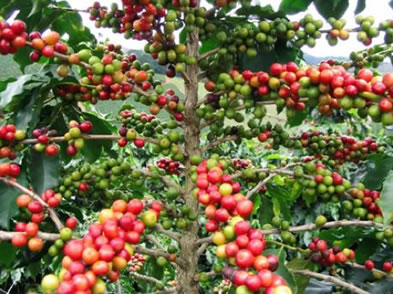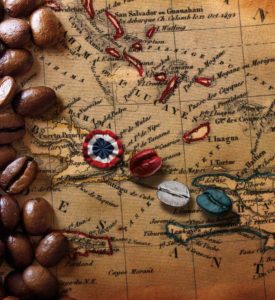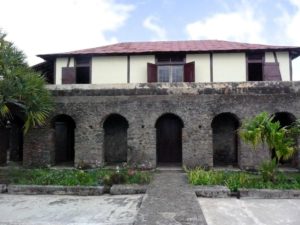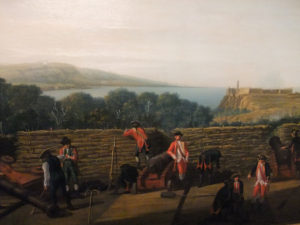COFFEE, A BOOST TO OUR NATIONAL HISTORY.
90% of the global supply of coffee is obtained from the arabica coffee species, of which there are about fifteen varieties.
Coffee is a strictly tropical crop that requires a more or less cool climate and not very wet. The fruit, called cherry tree, is a small spherical drupe containing two seeds, the seeds of coffee.
It is unknown the exact date at which began to grow coffee, but some scholars place this fact in Arabia, around the 17TH century which encouraged the Dutch to cultivate it in their colonies.
NATIONAL HISTORY.
In the largest archipelago in the West Indies this cultivation is one of the lines of the national economy that requires much effort, given the ecological conditions prevailing in the country.
José Antonio Gelabert who introduced in Cuba the first coffee trees in 1748 and started, its cultivation in area close to Havana. However, the real boom came in the early 1990s: the revolt of slaves in Haiti had exploded, coffee plantations were wiped out and their owners with the slaves fled to the nearby Caribbean nation.
Some French settlers were lucky twice; they left alive of the revolution of the slaves and arrived in Cuba where awaiting them a unique nature with the best conditions for the production of coffee. They initiated its cultivation in the Highlands of the Sierra Maestra and entered the correct practice of the benefit of the grain.
The history of coffee has been wrapped in a mantle of legends, deductions and information of dubious credibility, admitting today that the most widespread species in the world is the Coffea arábica. In its origins the most popular drink concoction was reserved for the more privileged classes of society because of its rarity and value.
One of the most popular legends is an Arab Shepherd named Fausto de Kaédi who noticed that their goats became playful and cheerful after eating cherries and twigs.
The Shepherd of goats recounted her experience to the prior or Abbot of a nearby monastery, who tasted the fruits and noticed that they exercised on the same effect, then he did some of his monks to test it and managed to stay awake.
Religious zealots of Venice and Rome in the second half of the 16TH century denounced it as the drink of Satan for unbelievers.
The use of coffee, its consumption is met in the East at the beginning of various vicissitudes being convicted more than once of several guards of the social order, political and religious.
Opened in Cuba when in 1762 Havana was taken by British troops, the coffee houses; It is believed that by that time already in our country some landowners planted coffee plant for its own use.
The first establishment for the sale of made-to-order BREW coffee was in the coffee of the tavern on the old square on the corner of la Merced Street. More in Matanzas, Camagüey, Cienfuegos, and Caibarién coffee houses opened in the years 1880 – 1900.
Agencies / Rad. Encyclopedia/Juan B. Rodriguez / Internet Photos/Arnoldo Varona/TheCubanHistory.com
THE CUBAN HISTORY, HOLLYWOOD.
FOLLOW US ON TWITTER AND FACEBOOK. THECUBANHISTORY.COM
EL CAFÉ, UN ESTÍMULO PARA NUESTRA HISTORIA.
El 90% del suministro mundial de café se obtiene de la especie coffee arábica, de la cual existen unas quince variedades.
El café es un cultivo estrictamente tropical que requiere de un clima más o menos fresco y no muy húmedo. El fruto, denominado cerezo, es una pequeña drupa esférica que contiene dos semillas, las semillas de café.
Se desconoce la fecha exacta en que empezó a cultivarse el café, pero algunos estudiosos sitúan este hecho en Arabia, alrededor del Siglo XVII lo que animó a los holandeses a cultivarlo en sus colonias.
Historia Nacional.
En el mayor archipiélago de las Antillas este cultivo constituye unos de los renglones de la economía nacional que requiere de mayor esfuerzo, dadas las condiciones ecológicas existentes en el país.
Fue José Antonio Gelabert quien introdujo en Cuba los primeros cafetos en 1748 e inició, su cultivo en zona próxima a La Habana. Sin embargo, el verdadero auge llegó en la década de los noventa: Había estallado la revuelta de los esclavos en Haití, las plantaciones de café fueron arrasadas y sus propietarios con los esclavos huyeron hacia la cercana nación caribeña.
Algunos colonos franceses tuvieron suerte por partida doble; salieron vivos de la revolución de los esclavos y llegaron a Cuba donde los aguardaba una naturaleza única con las mejores condiciones para la producción del café. Iniciaron su cultivo en las zonas altas de la Sierra Maestra e introdujeron la práctica correcta del beneficio del grano.
La historia del café ha estado envuelta en un manto de leyendas, deducciones e informaciones de dudosa credibilidad, admitiéndose hoy que la especie más difundida en el mundo es la Coffea arábica. En sus orígenes el brebaje más popular de la bebida fue reservado a las clases más privilegiadas de la sociedad a causa de su rareza y valor.
Una de las leyendas más populares es la de un pastor árabe llamado Fausto de Kaédi que notó que sus cabras se ponían juguetonas y alegres después de haber comido las cerezas y ramillas.
El pastor de las cabras contó su experiencia al prior o abate de un monasterio cercano, quien probó las frutas y notó que ejercían sobre él igual efecto, luego hizo que lo probaran algunos de sus monjes y consiguió que se mantuvieran despiertos.
Fanáticos religiosos de Venecia y de Roma en la segunda mitad del siglo XVI lo denunciaron como la bebida de Satanás para los incrédulos.
El uso del café, su consumo se conoció en el oriente al principio de diversas vicisitudes siendo condenadas más de una vez por varios protectores del orden social, políticos y religiosos.
En Cuba cuando en 1762 fue tomada La Habana por las tropas inglesas, se abrieron las casas del café; se cree que para esa época ya en nuestro país algunos hacendados sembraban cafeto para su uso propio.
El primer establecimiento para la venta de café acabadito de colar fue en el Café de la Taberna en la Plaza Vieja en la esquina de la Calle Merced. En los años 1880-1900 se abrieron más casas de café en Matanzas, Camagüey, Cienfuegos y Caibarién.
Agencies/Rad. Encyclopedia/Juan B. Rodríguez/ Internet Photos/Arnoldo Varona/TheCubanHistory.com
THE CUBAN HISTORY, HOLLYWOOD.









